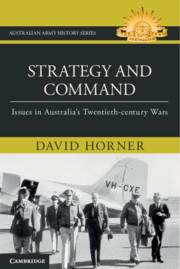Book contents
- Strategy and Command
- Other titles in the Australian Army History Series
- Acknowledgement of Country
- Strategy and Command
- Copyright page
- Contents
- Figures, maps and tables
- Preface
- Acknowledgements
- Abbreviations
- Introduction
- Chapter 1 The influence of the Boer War on Australia’s First World War commanders
- Chapter 2 Preparing for war, 1901–14
- Chapter 3 The AIF’s commanders
- Chapter 4 Strategic planning between the wars
- Chapter 5 Identifying the threat from Japan in 1941
- Chapter 6 A pivotal year in Australian history: 1942
- Chapter 7 Australia and coalition warfare in the Second World War
- Chapter 8 Deciding Australia’s war strategy in 1943
- Chapter 9 Advancing national interests
- Chapter 10 Higher command in the Korean War
- Chapter 11 Higher direction of the army in the Vietnam War
- Chapter 12 The Gulf War, 1991
- Chapter 13 Deploying and sustaining INTERFET in East Timor in 1999
- Chapter 14 Developing a command structure for joint operations
- Notes
- Bibliography
- Index
Chapter 1 - The influence of the Boer War on Australia’s First World War commanders
Published online by Cambridge University Press: 08 October 2021
- Strategy and Command
- Other titles in the Australian Army History Series
- Acknowledgement of Country
- Strategy and Command
- Copyright page
- Contents
- Figures, maps and tables
- Preface
- Acknowledgements
- Abbreviations
- Introduction
- Chapter 1 The influence of the Boer War on Australia’s First World War commanders
- Chapter 2 Preparing for war, 1901–14
- Chapter 3 The AIF’s commanders
- Chapter 4 Strategic planning between the wars
- Chapter 5 Identifying the threat from Japan in 1941
- Chapter 6 A pivotal year in Australian history: 1942
- Chapter 7 Australia and coalition warfare in the Second World War
- Chapter 8 Deciding Australia’s war strategy in 1943
- Chapter 9 Advancing national interests
- Chapter 10 Higher command in the Korean War
- Chapter 11 Higher direction of the army in the Vietnam War
- Chapter 12 The Gulf War, 1991
- Chapter 13 Deploying and sustaining INTERFET in East Timor in 1999
- Chapter 14 Developing a command structure for joint operations
- Notes
- Bibliography
- Index
Summary
The great nineteenth-century Prussian general Field Marshal Helmuth von Moltke, ‘The Elder’, once declared that no operations plan survives contact with the enemy. But no one has suggested – least of all Moltke – that an army or a commander contemplating a military operation should have no plan. The same can be said about previous experience of war. A new war is likely to have such a different shape and character from the previous one that previous experience might be found to be of no value or, indeed, even misleading. Army commanders are often accused of preparing for the past war rather than the future one. But no one has suggested that previous wartime experience is not valuable in an army about to embark on a new war.
Keywords
- Type
- Chapter
- Information
- Strategy and CommandIssues in Australia's Twentieth-century Wars, pp. 4 - 26Publisher: Cambridge University PressPrint publication year: 2021



